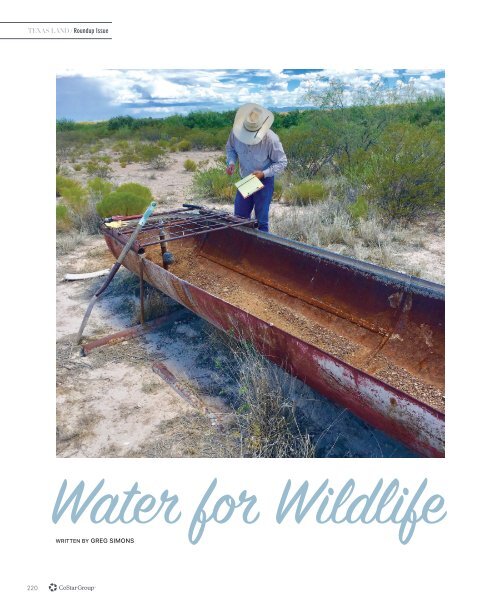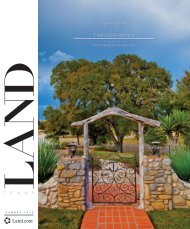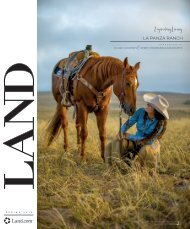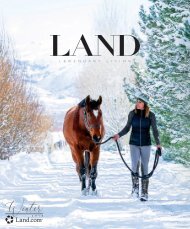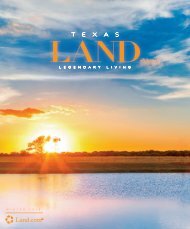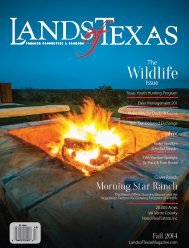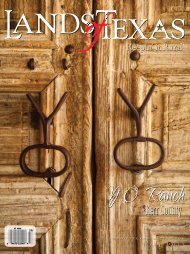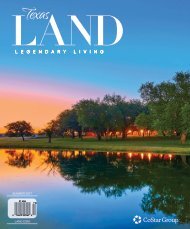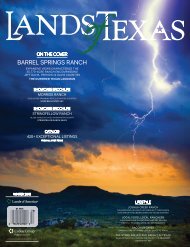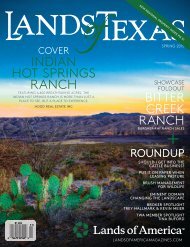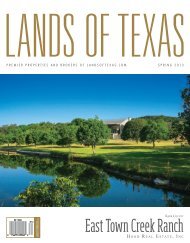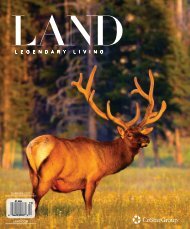You also want an ePaper? Increase the reach of your titles
YUMPU automatically turns print PDFs into web optimized ePapers that Google loves.
TEXAS LAND / Roundup Issue<br />
<strong>Water</strong> <strong>for</strong> <strong>Wildlife</strong><br />
WRITTEN BY GREG SIMONS<br />
220
V<br />
alues associated with wildlife are significant and<br />
diverse. It’s been estimated that the economic impact<br />
of hunting and fishing in Texas contributes over $3.3<br />
billion annually to our state’s economy. Additionally,<br />
people not only simply value wildlife from a monetized<br />
standpoint, but also in other contexts, as well. These other<br />
diverse values of wildlife may include recreational, aesthetic,<br />
spiritual, emotional, and ecological values. Thus, attention to<br />
providing requisites <strong>for</strong> enhanced wildlife habitability is not<br />
only good <strong>for</strong> wildlife, but it’s good <strong>for</strong> society. Since much of<br />
Texas is often described as an arid to semi-arid environment,<br />
there exists plenty of opportunities through creative, financial,<br />
and sweat equities to invest in water as a means of providing a<br />
better home <strong>for</strong> wild creatures and <strong>for</strong> people.<br />
<strong>Water</strong> as a Nutrient<br />
When discussing nutrients as part of the wildlife management<br />
conversation, it seems that there tends to be more gravitation<br />
toward discussing supplemental feeding and <strong>for</strong>age<br />
management, with water being an afterthought in many of<br />
these discussions. Protein pellets and food plots tend to be<br />
sexier than the colorless,<br />
tasteless, and odorless<br />
properties of water.<br />
However, make no mistake,<br />
when it comes to servicing<br />
the diverse function of the<br />
living body, water reigns<br />
king. <strong>Water</strong> is intricately<br />
involved with transport of<br />
other nutrients, oxygen,<br />
and waste into and out of<br />
the cells. It contains several<br />
necessary electrolytes, it<br />
is critical in the digestive<br />
process, and even acts as<br />
a cushioning component<br />
<strong>for</strong> joints, spinal cord, and<br />
brain. Though water has no<br />
calories, it does serve as a medium <strong>for</strong> chemical reactions that<br />
are part of our normal bodily processes including the metabolic<br />
reactions involved in energy production. So, when discussing<br />
strategies <strong>for</strong> growing bigger deer, more quail, and creating<br />
greater wildlife diversity <strong>for</strong> backyard pleasure, it may be wise to<br />
move water to the front of the discussion line.<br />
Sources and Catchments<br />
When we think of how water ends up on our landscape, many<br />
people tend to think of that which falls from the sky. Indeed, the<br />
moisture that we receive from our atmosphere is necessary <strong>for</strong><br />
our planet’s survival, and when you look across the lands of<br />
Texas, the water that you see in the <strong>for</strong>m of dirt tanks, lakes,<br />
rivers, and potholes, is almost exclusively the result of rainfall.<br />
But let’s be reminded that there are some locales where soil<br />
types are simply not conducive <strong>for</strong> holding water, as the porosity<br />
may be too great. And as already mentioned, many areas of the<br />
state have long stretches in-between rainfall events, creating an<br />
environment where evaporation, percolation, and water usage<br />
simply exceeds what is captured from rainwater run-off. There<br />
are ways to manage around some of this shortfall, such as lining<br />
dirt tanks with bentonite clay or even using artificial liners, but<br />
droughts can still create problems when we are strictly relying<br />
on rainwater in arid regions.<br />
The other primary source <strong>for</strong> creating available surface water<br />
<strong>for</strong> the benefit of wildlife (and livestock), is by pumping it from<br />
the depths of the earth to the surface of the land, and then<br />
distributing it and making it available through drinking devices.<br />
The primary options <strong>for</strong> pumping groundwater to the surface is<br />
either through windmills or submersible pumps. Once pulled to<br />
the surface of ground, the now available water is often stored<br />
in an artificial tank, and is then delivered to a trough or drinker.<br />
Troughs are typically in the <strong>for</strong>m of cement, plastic, or metal<br />
containers. Large properties will often feature extensive pipeline<br />
infrastructure where miles of pipelines are laid, generally<br />
through PVC, or these<br />
days, through polyethylene<br />
pipe, which is more durable<br />
than traditional PVC.<br />
Guzzlers are another option<br />
<strong>for</strong> providing wildlife water<br />
in arid regions or locales<br />
where groundwater is not<br />
available. The guzzler<br />
concept is typically based<br />
on having an apron which<br />
increases the collection<br />
area from rainwater, and<br />
the apron will funnel into<br />
a storage container that is<br />
fully enclosed to reduce<br />
evaporation, and is then<br />
fed through a pipe into a small drinker. Guzzlers have been<br />
especially popularized through some of the desert bighorn<br />
restoration projects in Texas and elsewhere.<br />
Distribution Counts<br />
Since water can be a weak link in the habitability matrix <strong>for</strong><br />
a variety of wildlife, one of the fundamental premises is that<br />
increased distribution of water allows <strong>for</strong> increased usable<br />
space <strong>for</strong> those localized populations of wildlife. Thus, there is<br />
enhanced efficiency in making use of all habitat features across<br />
the landscape by bridging this distribution of use through water<br />
provisions. Increased water distribution addresses fragmented<br />
characteristics of habitat, minimizing “island-affects” and<br />
helping to trans<strong>for</strong>m patchy habitat characteristics into larger<br />
livable space <strong>for</strong> those populations of wildlife living in those<br />
LANDMAGAZINES.COM<br />
221
TEXAS LAND / Roundup Issue<br />
areas. In addition to increasing wildlife population numbers<br />
through improved water distribution, these same populations<br />
tend to also be more stable with greater resilience to various<br />
environmental pressures.<br />
Don’t Forget the Small Critters<br />
Accessibility to surface water is sometimes an overlooked feature<br />
when water troughs are implemented. The limiter <strong>for</strong> accessibility<br />
is generally created through too much distance from the top of the<br />
trough to the surface of the water. Fawns, birds, small mammals,<br />
and even reptiles are sold short when they cannot access the<br />
water. This accessibility issue can be easily mitigated by stacking<br />
large rocks at one end of the trough, or using expanded metal<br />
that is shaped like inverted V and provides a sloping plat<strong>for</strong>m<br />
<strong>for</strong> crawling up from the ground and down to the water’s edge,<br />
or even wiring a log to the side of the trough; anything creates a<br />
perch <strong>for</strong> accessing the water. Overflows are also great ways to<br />
create wildlife-friendly watering locations.<br />
<strong>Water</strong> and Tax Consequences<br />
Passed in 1995, Proposition 11 allows Texas private landowners<br />
to qualify <strong>for</strong> their 1-d-1 Open Space Ag. Valuation through a<br />
provision of wildlife management use. Part of the requirements<br />
of this ad valorem tax valuation is an approved wildlife<br />
management plan that includes at least three of the seven<br />
designated wildlife management practices, including water<br />
development. Thus, another important feature of private<br />
landowners actively implementing water improvements <strong>for</strong><br />
wildlife, is that this investment may be applied toward a wildlife<br />
valuation, should the landowner choose to go that route. The<br />
central appraisal district (CAD) within each county can provide<br />
more details, or you can consult a private consultant, such as<br />
<strong>Wildlife</strong> Consultants, LLC.<br />
To seek consultation on various wildlife and hunting<br />
related matters, contact Greg Simons or Ruben Cantu at<br />
(325) 655-0877 or go to www.The<strong>Wildlife</strong>Consultants.com.<br />
222
G r e g S i m o n s<br />
<strong>Wildlife</strong> Biologist<br />
<strong>Wildlife</strong>@<strong>Wildlife</strong>Systems.com<br />
O u r P h i l o s o p h y<br />
The health of habitat and<br />
wildlife is related directly to<br />
the committed stewardship<br />
of private landowners and<br />
land managers. As wildlife<br />
biologists, we understand<br />
that it’s our job to help<br />
landowners and land<br />
managers achieve their goals,<br />
which in turn helps keep<br />
open space land sustainably<br />
productive and ecologically<br />
functional, benefiting us all.<br />
R u b e n C a n t u<br />
<strong>Wildlife</strong> Biologist<br />
Ruben@The<strong>Wildlife</strong>Consultants.com<br />
W i l d l i f e C o n s u l t i n g & H u n t i n g S e r v i c e s<br />
( 3 2 5 ) 6 5 5 - 0 8 7 7<br />
w w w . T h e W i l d l i f e C o n s u l t a n t s . c o m


